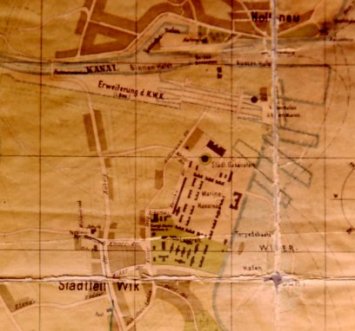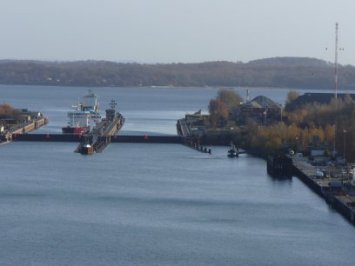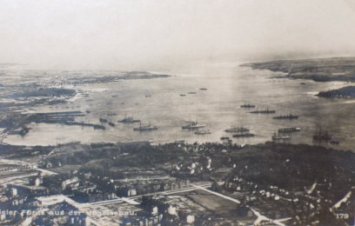Homepage Renate and Klaus Kuhl - Sailors' revolt in Kiel
Virtual Sightseeing Tour "Kiel Mutiny" Nov. 1918
[01] [02] [03] [04] [05] [06] [07] [08] [09] [10] [11] [12]
No. 01: The III. Squadron arrives at the Holtenau Locks in Kiel during the Night of 1 November 1918
The fleet commander Vizeadmiral Kraft redeploys the III. squadron from Wilhelmshaven to Kiel. Moving through the Kaiser-Wilhelm-Kanal (now Kiel canal) 48 putative ringleaders of the "Markgraf" are arrested and brought from Holtenau (end of the canal in Kiel) to the military prisons in Kiel, Feldstrasse and Fort Herwarth in the North. The ships ("König", "Bayern", "Großer Kurfürst", "Kronprinz" und "Markgraf") containing above 5000 personnel arrive in Kiel during the night of 1 November.
| Present day map | Former map |
|
Größere Kartenansicht | 
|
| From the Holtenau viaduct (Prinz-Heinrich-Str.) you can enjoy a nice view at the locks and partly at the barracks in Kiel-Wik. | Holtenau locks and barracks in Kiel-Wik ca. 1920 |
| Present day view | Former view |
 |
 |
| View at the locks from the Holtenau viaduct; photo K. Kuhl, 2009 |
View from South-West at the Kiel Firth 1918, in the middle of the left side the Kaiser-Wilhelm-Kanal runs into the firth; Kieler Stadtarchiv |
Explanations of the events::
With the incidence of 1917 still in mind (Albin Köbis und
Max Reichpietsch wurden wegen Meuterei erschossen) it was clear
for the sailors, that it could be death penalty for the imprisoned.
Therefore they were very determined to free their comrades by
all means. The generously granted shore leave for the ships' crews
is utilizsed by about 250 sailors from the III. squadron to meet
at the union house in the Fährstraße (nowadays renamed
to Legienstraße) in the evening.
At 3 November in the morning 57 more sailors and stokers are rounded up on board the 'Markgraf'. But they can only be brought to Fort Herwarth after "Zureden (beseeching)" the crew.
The virtual sightseeing tour at a glance:
- Holtenau viaduct and locks >>
- Large drillground (Großer Exerzierplatz) >>
- Karlstraße / Langer Segen >>
- Torpedo workshop Friedrichsort, Germania shipyard Kiel-Gaarden >>
- Barracks (Kasernen) in Kiel-Wik >>
- Marinestation Ostsee >>
- Arrestanstalt (military prison >>
- Trade union house (Gewerkschaftshaus) >>
- Town hall (Rathaus) >>
- "Schloßhof" >>
- Station (Bahnhof) >>
- Graves of the killed revolutionaries and soldiers >>
Real, guided tours on this subject are offered by:
- Geo-Step-by-Step >>
- Ernst Mühlenbrink, via Society for Kiel's Town History
(Gesellschaft für Kieler Stadtgeschichte) >>
- AKENS, Asche Arbeitskreis >>
Last modified: 15 Aug. 2018
| Sailors' Revolt / Kiel Mutiny November 1918 - here you'll find the following further information:
|
